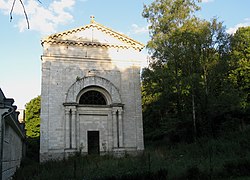Le Gard Monastery
| Cistercian Abbey of Le Gard | |
|---|---|
 Ruinous facade of the abbey church |
|
| location |
Region Hauts-de-France Somme department |
| Coordinates: | 49 ° 57 '49 " N , 2 ° 6' 12" E |
| founding year | 1137 |
| Year of dissolution / annulment |
1790 |
| Year of repopulation | 1816 (Trappist) |
| Year of re-dissolution | 1845 (Trappist) |
| Mother monastery | Cherlieu Monastery |
| Primary Abbey | Clairvaux Monastery |
|
Daughter monasteries |
none in the Middle Ages |
The Monastery Le Gard was a Cistercian abbey in the town of Crouy-Saint-Pierre in the Somme region Hauts-de-France in France . It was about 16 km northwest of Amiens on the slope on the southern bank of the Somme .
history
The abbey , founded in 1137 by Gérard de Picquigny, Vidame d'Amiens , and settled with monks from the Cherlieu monastery , belonged to the filiation of the Clairvaux Primary Abbey . She had the granges Quesnot, Hermilly, Valheureux, la Vicogne and Longuevillette. Armed conflicts forced the construction of townhouses in Abbeville (“Le Petit Gard” from 1250, in which the first printing works in Picardy was set up) and Amiens . From 1657 until his death in 1661, Jules Mazarin was Commendarabbot of Le Gard. In the middle of the 18th century the dilapidated cloister and the dormitory had to be demolished. Some of the buildings were rebuilt between 1752 and 1762. During the French Revolution only 10 monks lived in the monastery, which was abandoned, sold and partially demolished. In 1816 the abbey was re-established as Trappist monastery by Darfeld monastery , and the Trappists stayed until 1845. In 1826 they founded the daughter monastery of Mont des Cats in Godewaersvelde in French Flanders near the Belgian border and in 1828 in Bellevaux in the diocese of Besançon and Saint-Sixte monastery in of the Diocese of Bruges. After 1845 various religious communities broke away. The buildings fell into disrepair until 1967 when restoration began. In 1969 it was classified as a monument historique . The abbey is currently looking forward to a new use, probably as a seminar hotel.
Buildings and plant
The baroque monastery church became a ruin after the revolution, but was rebuilt after 1816. After 1906 it fell into disrepair, but its enclosing walls are still upright. To the north of the church stands the large corps de logis and next to it a part of the cloister. The movable inventory of the church ended up in the churches of Hangest-sur-Somme and Crouy .
literature
- Bernard Peugniez: Routier cistercien. Abbayes et sites. France, Belgique, Luxembourg, Suisse. Nouvelle édition augmentée. Éditions Gaud, Moisenay 2001, ISBN 2-84080-044-6 , pp. 383-384.